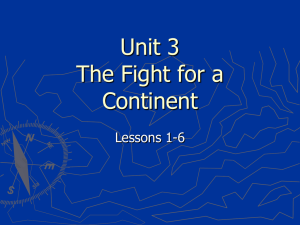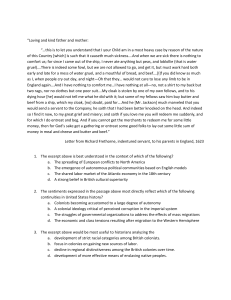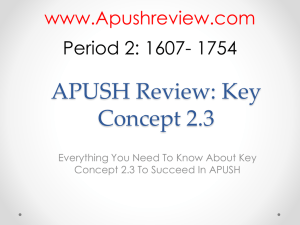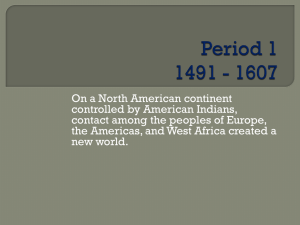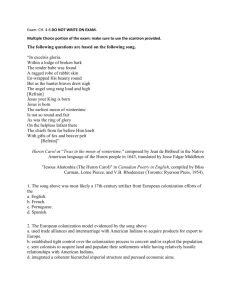Unit 1 & 2 History Exam: Colonial America
advertisement
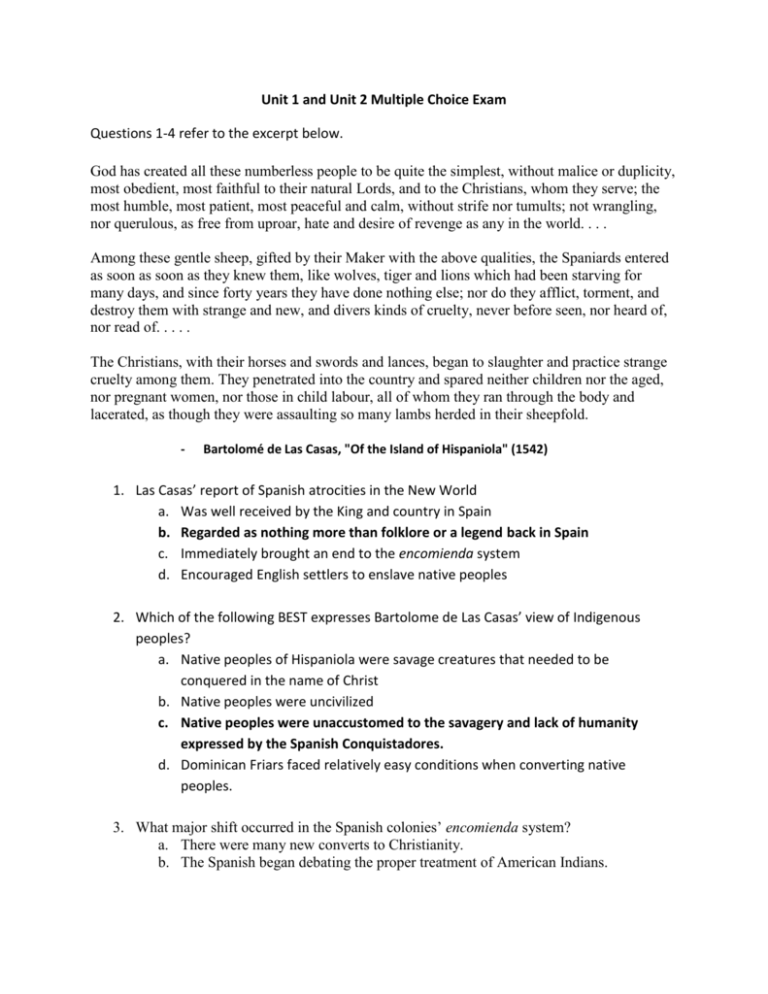
Unit 1 and Unit 2 Multiple Choice Exam Questions 1-4 refer to the excerpt below. God has created all these numberless people to be quite the simplest, without malice or duplicity, most obedient, most faithful to their natural Lords, and to the Christians, whom they serve; the most humble, most patient, most peaceful and calm, without strife nor tumults; not wrangling, nor querulous, as free from uproar, hate and desire of revenge as any in the world. . . . Among these gentle sheep, gifted by their Maker with the above qualities, the Spaniards entered as soon as soon as they knew them, like wolves, tiger and lions which had been starving for many days, and since forty years they have done nothing else; nor do they afflict, torment, and destroy them with strange and new, and divers kinds of cruelty, never before seen, nor heard of, nor read of. . . . . The Christians, with their horses and swords and lances, began to slaughter and practice strange cruelty among them. They penetrated into the country and spared neither children nor the aged, nor pregnant women, nor those in child labour, all of whom they ran through the body and lacerated, as though they were assaulting so many lambs herded in their sheepfold. - Bartolomé de Las Casas, "Of the Island of Hispaniola" (1542) 1. Las Casas’ report of Spanish atrocities in the New World a. Was well received by the King and country in Spain b. Regarded as nothing more than folklore or a legend back in Spain c. Immediately brought an end to the encomienda system d. Encouraged English settlers to enslave native peoples 2. Which of the following BEST expresses Bartolome de Las Casas’ view of Indigenous peoples? a. Native peoples of Hispaniola were savage creatures that needed to be conquered in the name of Christ b. Native peoples were uncivilized c. Native peoples were unaccustomed to the savagery and lack of humanity expressed by the Spanish Conquistadores. d. Dominican Friars faced relatively easy conditions when converting native peoples. 3. What major shift occurred in the Spanish colonies’ encomienda system? a. There were many new converts to Christianity. b. The Spanish began debating the proper treatment of American Indians. c. Social, religious, political, and economic competition with other European nations developed. d. Indian labor was gradually replaced with African slavery. 4. Bartolome de Las Casas is best viewed as a. The first advocate of universal human rights in the New World b. A martyr c. Promoter of mestizo relations d. A symbol of freedom for 19th Century Independence movements. Questions 5 and 6 refer to the excerpt below. “… (a) major consequence of the Pueblo Revolt was the opportunity it afforded Indian rebels to acquire hundreds of coveted Spanish horses. The Pueblos in turn established a thriving horse trade with Navajos, Apaches, and other tribes… (horses) soon spread across the Great Plains, the vast rolling grasslands extending from the Missouri River valley in the east to the base of the Rocky Mountains in the west.” - George Brown Tindall and David Emory Shi in America: A Narrative History, 8e. 5. Which of the following was a major impact of the introduction of the horse to the Plains Indians? a. The horse allowed Plains Indians the ability to become sedentary. b. The horse stopped the intense competition between the various Indian nations over food and land. c. The horse consumed the primary food soruce of the bison, causing the bison population to dwindle. d. The horse allowed the Plains Indians to become more efficient in hunting and caused them to become more nomadic. 6. Which of the following describes the Spanish reaction to the Pueblo Revolt? a. The Spanish enslaved the natives b. The Spanish decided that it would be advantageous to work with the Pueblo as allies rather than enemies and sided with the Pueblo to conquer their neighboring enemies. c. The Spanish killed several Pueblo and mutilated or enslaved the survivors. d. For the first time in their new empire, the Spanish implemented the encomienda system to Christianize the Pueblo. Questions 7-9 refer to the excerpt below. “… though under the greatest Enjoyment of Civil Liberties, if abridged of the Freedom of their Consciences, as to their Religious Profession and Worship: And Almighty God being the only Lord of Conscience, Father of Lights and Spirits; and the Author as well as Object of all divine Knowledge, Faith and Worship, who only doth enlighten the Minds, and persuade and convince the Understandings of People, I do hereby grant and declare, That no Person or Persons, inhabiting In this Province or Territories, who shall confess and acknowledge One almighty God, the Creator, Upholder and Ruler of the World; and professes him or themselves obliged to live quietly under the Civil Government, shall be in any Case molested or prejudiced, in his or their Person or Estate, …” - William Penn, Pennsylvania Charter of Privileges, October 28, 1701 7. In what way was the main idea in the excerpt a departure from the other colonies in British North America? a. With few exceptions, other British North American colonies had one established faith. b. Pennsylvania was the first colony to tolerate all religious beliefs. c. Settlers in Pennsylvania were required to attend church services d. Puritan ideas were banned from the colony. 8. Which of the following events from the colonial era is most like the ideas expressed in the excerpt from the Charter of Privileges? a. The ideas of John Locke and their influence on the Enlightenment b. The theological beliefs of Roger Williams in his founding of Rhode Island c. The Carolina Charter d. The Maryland Act of Toleration 9. The previous excerpt is most similar to the sentiments expressed in which of the following? a. The Declaration of Independence b. The South Carolina Exposition and Protest c. The Bill of Rights d. The Alien and Sedition Acts Questions 10-14 refer to the excerpt below. LETTER OF JOHN ROLFE, 1614 The coppie of the Gentle-mans letters to Sir Thomas Dale, that after married Powhatans daughter, containing the reasons moving him thereunto. Honourable Sir, and most worthy Governor: When your leasure shall best serve you to peruse these lines, I trust in God, the beginning will not strike you into a greater admiration,1 then the end will give you good content. It… Let therefore this my well advised protestation, which here I make betweene God and my own conscience, be a sufficient witnesse, at the dreadfull day of judgement (when the secret of all mens harts shall be opened) to condemne me herein, if my chiefest intent and purpose be not, to strive with all my power of body and minde, in the undertaking of so mightie a matter, no way led (so farre forth as mans weakenesse may permit) with the unbridled desire of carnall affection: but for the good of this plantation, for the honour of our countrie, for the glory of God, for my owne salvation, and for the converting to the true knowledge of God and Jesus Christ, an unbeleeving creature, namely Pokahuntas. To whom my hartie and best thoughts are, and have a long time bin so intagled, and inthralled in so intricate a laborinth, that I was even awearied to unwinde my selfe thereout. But almighty God, who never… 10. The Virginia Company attracted new settlers to its colony after 1609 by… a. offering them a share of the company’s profits b. advertising the benefits of Virginia’s healthy environment and comfortable living conditions. c. promising free land at the end of the seven years’ labor for the company d. paying significantly higher wages than those prevailing throughout Euroepa. 11. According to his letter, John Rolfe’s marriage to Pocahontas was characterized by all of the following EXCEPT a. A holy union for the good of the plantation b. The culmination of a long time love for Pocahontas c. A desire to learn Powhatan defense secrets so English colonists could gain a strategic military advantage. d. A desire to convert Pocahontas to Christianity 12. Initially, native peoples of the Chesapeake Bay did not fear White settlers because a. they believed English colonists would self-terminate b. they believed English colonists would be overrun by the Spanish c. more English settlers were going to arrive from Europe d. Jamestown had proven colonists would forever remain self-sufficient and prosperous from tobacco 13. All of the following are characteristics of the Virginia Company of London’s settlement at Jamestown EXCEPT a. Most of the initial colonists were unskilled laborers b. Tobacco eventually brought economic prosperity to Jamestown c. Indentured servants faced a high mortality rate d. Most settlers were Puritans or Pilgrims that were fleeing religious persecution in Europe. 14. Indentured servants were important to the development of 17th century Chesapeake Bay because they a. Were usually artisans who brought needed skills to the area. b. Provided a relatively cheap and abundant source of labor for Chesapeake tobacco planters. c. Brought new ideas concerning the cultivation and cure of tobacco. d. Provided labor for important public projects undertaken by the colonial governments of Virginia and Maryland Questions 15-17 refer to the quotes below. “In order to populate the colony [we need] to permit marriages between Frenchmen and Catholic Indian women.” - Father Henri Roulleaux de La Vente, 1714 “We forbid out White subjects of either sex from contracting marriage with Blacks… [and] also forbid our said White subjects… from living in concubinage with slaves.” - Code Noir, 1724 15. Based on the above quotations, all of the following are true of early 18th Century French Louisiana EXCEPT a. The French promoted ideas of assimilation b. Intermarriage occurred between Indians and French settlers c. Intermarriage between Blacks and French settlers was discouraged d. Jesuits did not encourage the conversion of natives to Catholicism 16. Early 18th Century French attitudes towards interacting with native peoples in French Louisiana were a stark contrast from which of the following colonizing groups: a. Spanish settlers in New Spain b. French fur trappers in the Great Lakes region c. English Colonists in Massachusetts Bay d. Dutch settlers along the Hudson River 17. Contextualizing: Based on the above quotations, which of the following is true of early 18th Century French Louisiana: a. Mulattos composed a majority of the population in New France b. Métis sage (mixing of races) occurred in French Louisiana c. New France had a disproportionately large population of white European women d. Catholic missionaries did not settle French Louisiana Questions 18-20 refer to the following passage. “Maize swept into Africa as introduced disease was leveling Indian societies. Faced with a labor shortage, the Europeans turned their eyes to Africa. The continent’s quarrelsome societies helped them siphon off millions of people.” - From 1491 by Charles C. Mann, Vintage Books: New York, 2006, p. 224 18. The main impact of European exploration on American Indians at the onset of the establishment of the Columbian Exchange was a. The native population was forced off their land as slave labor was imported from Africa b. The introduction of diseases like smallpox led to a decimation of the American Indian population c. Spanish and Portuguese explorers cut American-Indian nations off from trade routes, leading to mass starvation d. The introduction of the horse by the Spanish-led American Indians to hunt more and depend upon maize and other crops less. 19. The most significant impact of the introduction of sugarcane in the West Indies was a. The need for slave labor from Africa to maintain constant production of sugar b. The desire of the Spanish to settle the Western Hemisphere with permanent settlements made up of families. c. The development of a continuous was between Spain and Portugal over Caribbean islands d. The destruction of the ecosystem of many Caribbean islands resulting in the death of thousands of natives. 20. As described in the above reading, the Columbian Exchange was significant in that it had the greatest impact on which group of people? a. Africans; they received a greater variety of foodstuffs from Europe, in turn increasing their population significantly. b. Europeans; their wealth increased c. Native Americans; they were enslaved by the encomienda system by the thousands. d. Europeans; new, easier-to-grow foodstuffs such as corn and potatoes were brought from the New World and allowed impoverished population groups to survive and increase their numbers. Questions 21-24 refer to the following passage. “We, whose names are underwritten, the Loyal Subjects of our dread Sovereign Lord, King James, by the Grace of God, of Great Britain, France and Ireland, King, Defender of the Faith, etc. Having undertaken for the Glory of God, and Advancement of the Christian Faith, and the Honour of our King and Country, a voyage to plant the first colony in the northern Parts of Virginia; do by these Presents, solemnly and mutually in the Presence of God and one of another, covenant and combine ourselves together into a civil Body Politick, for our better Ordering and Preservation, and Furtherance of the Ends aforesaid; And by Virtue hereof to enact, constitute, and frame, such just and equal Laws, Ordinances, Acts, Constitutions and Offices, from time to time, as shall be thought most meet and convenient for the General good of the Colony; unto which we promise all due Submission and Obedience.” - Excerpted from the Mayflower Compact, November 11, 1620 21. Which of the following had the greatest influence on the Massachusetts Bay Colony a. William Penn’s Holy Experiment b. King Charles I c. Puritan ideologies d. Catholic missionaries 22. The main idea of this document influenced which of the following ideals of the British North American colonies? a. The idea of separation of church and state b. The concept that the colonies need to be governed by a constitution c. The concept of rule by majority, as in town meetings d. The foundation for social equality 23. Which of the following groups would most likely support the main concepts of the Mayflower Compact? a. Delegates to the Stamp Act Congress b. Supporters of the Articles of Confederation c. Persons living in the New Harmony, Indiana communal society d. Delegates to the Constitutional Convention in 1787 24. The excerpt from the Mayflower Compact clearly reflects which of the following? a. The English were establishing North American colonies based on the Spanish encomienda system. b. The English were attempting to establish permanent communities. c. The English were prepared to challenge French claims in North America. d. Instructions that the English settlers in North America were to establish communities identical to those in England. Questions 25-27 refer to the following image. The Burning of Jamestown by Howard Pyle, 1905, depicting the burning of Jamestown, Virginia during Bacon’s Rebellion 25. The major cause of Bacon’s Rebellion was the competing perceptions of power in 17 th century Virginia. Which of the following best describes the differing perceptions? a. The difference in the amount of land available to settlers in the Tidewater region and in western Virginia; settlers in the Tidewater region had more land. b. The competing desires for economic equality and power between the different regions of Virginia c. The difference in political power between the eastern plantation owners and the newer settlers in the west, with the advantage going to the plantation owners in the east d. The fact that settlers in the western portion of the colony were mainly former indentured servants who had no political rights. 26. The philosophical ideology that led to Bacon’s Rebellion would have motivated which of the following groups later in America? a. South Carolina politicians who supported nullification of the federal tariff in the 1830s b. Western Pennsylvania farmers who opposed the Whiskey Tax in the 1790s c. Americans in Texas who opposed the conditions Mexico imposed on them for moving into Texas in the 1830s d. Abolitionists who were becoming more radically antislavery in the 1850s 27. The event expressed in the picture most clearly demonstrates the influence of which of the following? a. Royal authority that tended to discount lower-class groups during the 17th century b. Belief of the people that there should be separation between church and state c. Desire for more economic equality between the plantation and yeoman farmer classes d. The strong desire for social equality during the colonial era Questions 28-31 refer to the following illustration. 28. The “Middle Passage” of Triangular Trade was most known for transporting a. Cotton and sugar b. Slaves c. Manufactured goods d. Tobacco, cotton, sugar, and molasses 29. What conclusion can be drawn from the illustration? a. Slaves were sold from Africa to Europe in exchange for manufactured goods. b. Europe depended on manufactured goods to trade for tobacco, cotton, sugar, and molasses c. European merchants were most likely the transporters of slaves from Africa to the Americas. d. Merchants often exchanged raw materials for African slaves. 30. Triangular trade was part of what colonial economic practice? a. Imperialism b. Mercantilism c. Utopianism d. Unitarianism 31. Sixteenth-century African slaves in the Western Hemisphere best preserved autonomy and linguistic traditions through a. domestic service roles. b. expanded land ownership. c. large-scale rebellion. d. maroon communities in the Caribbean. Questions 32-34 refer to the following quotation. “When Europeans first touched the shores of the Americas, Old World crops such as wheat, barley, rice, and turnips had not traveled west across the Atlantic, and New World crops such as maize, white potatoes, sweet potatoes, and manioc had not traveled east to Europe. In the Americas, there were no horses, cattle, sheep, or goats, all animals of Old World origin. Except for the llama, alpaca, dog, a few fowl, and guinea pig, the New World had no equivalents to the domesticated animals associated with the Old World, nor did it have the pathogens associated with the Old World’s dense populations of humans and such associated creatures as chickens, cattle, black rats, and Aedes egypti mosquitoes. Among these germs were those that carried smallpox, measles, chickenpox, influenza, malaria, and yellow fever.” - Alfred Crosby, “The Columbian Exchange” 32. Perhaps the most devastating aspect of the Columbian Exchange was a. The extinction of animals in the New World by invasive species b. The European diseases that decimated indigenous populations in the Americas c. The slave trade that became part of the Columbian Exchange between Africa and the New World d. The wave of explorers that ensued and began to populate the Americas and push the native people out of their homelands 33. Which of the following had a profound effect on the growth of agriculture in the New World? a. The introduction of maize, white potatoes, and sweet potatoes to the Americas b. The waves of settlers and explorers that began to populate the New World c. The horses, cattle, sheep, and goats that came from the Old to the New World d. The rise of African slavery that originated as part of the Middle Passage 34. Which of the following items was NOT indigenous to the New World a. Sweet potatoes b. Turkey c. Wheat d. Maize For question 35 refer to the following image. Cahokia 35. All of the following are true of Mississippian peoples EXCEPT a. They built large mounds for ceremonial purposes b. They utilized the Mississippi River system for irrigation c. They practiced an extensive judicial system that centered on human sacrifice d. They had large cities that were bigger than rival cities like London and Paris. Questions 36 and 37 refer to the following image. Mesa Verde, Colorado 36. Pre-Columbian Southwest Indians were most noted for which environmental transformation practice? a. Draining swamps b. Burning grasslands and forests c. Irrigation d. Overhunting and extinction of herd animals 37. The maize culture of the Southwest was most similar to the pre-Columbian culture of the a. Cahokia. b. Pueblo. c. Algonquian. d. Creek. Questions 38-40 refer to the following quote” “Now the onely way to avoyde this shipwracke and to provide for our posterity is to… knitt together in this worke as one man, wee must entertaine each other in brotherly Affeccion,… soe shall wee keepe the unitie of the spirit in the bond of peace, the Lord will be our God and delight to dwell among us, as his owne people and will commaund a blessing upon us in all our ways… that men shall say of succeeding plantacions: the lord make it like that of New England: for wee must Consider that wee shall be as a Citty upon a Hill, the eies of all people are uppon us; soe that if wee shall deale falsely with our god in this worke wee have undertaken and soe cause him to withdrawe his present help from us, wee shall be made a story and a byword through the world,… wee shall shame the faces of many of gods worthy servants, and cause theire prayers to be turned into Cursses upon us till wee be consumed out of the good land whether wee are going.” - John Winthrop, “City upon a Hill” sermon, 1630 38. To what group of people is John Winthrop speaking? a. Pilgrims b. Puritans c. Separatists d. Parliament 39. What city is Winthrop referring to as the “City upon a Hill”? a. Boston b. New York c. Jamestown d. Plymouth 40. Which of the following supports Winthrop’s vision for his “City upon a Hill”? a. He sought to establish a religious society that was accepting of all peoples and different religious beliefs b. He wanted to create a city based on purified Anglicanism and devoted to a Protestant work ethic. c. He wanted to establish a religious missionary to convert native peoples to Protestantism to gain favor within the Anglican Church d. He wanted his community to be a successful economic venture to pay off the joint-stock company that financed his establishment of a new city. Questions 41-43 refer to the following quote. “Many courageous fellows were unwilling to come out, and fought most desperately through the palisades, so as they were scorched and burnt with the very flame, and were deprived of their arms, in regard the fire burnt their very bowstrings, and so perished valiantly. Mercy they did deserve for their valor, could we have had opportunity to have bestowed it. Many were burnt in the fort, both men, women, and children. Others forced out, and came in troops to the Indians, twenty and thirty at a time, which our soldiers received and entertained with the point of the sword. Down fell men, women, and children: those that escaped us, fell into the hands of the Indians, that were in the rear of us; it is reported by themselves, that there were about four hundred souls in this fort, and not above five of them escaped out of our hands. Great and doleful was the bloody sight to the view of young soldiers that never had been in war, to see so many souls lie gasping on the ground so thick in some places, that you could hardly pass along.” - Excerpt from vol. I. The Transplanting of Culture: 1607-1650 by Captain John Underhilll 41. This account is a detail of what Anglo-Indian conflict? a. King Philip’s War b. The Powhatan Wars c. The Pequot War d. Pontiac’s Rebellion 42. The main reason the conflict described occurred was most likely because of what reason? a. The Indians had been raiding settlements along the Chesapeake Bay b. The English were avenging a killed trader and looking for an excuse to remove Indians from valuable land. c. The Indians burned an English fort, which caused Captain Underhill to avenge the fallen colonists. d. The Indians were pro-French and allied themselves to fight with the French against encroaching English settlers. 43. Which of the following best characterized the overall approach of English settlers to New England Indians in the 17th century? a. They often befriended the Indians and wished to assimilate them into their culture. b. The colonists learned to coexist with the natives and created a strong economic relationship c. The Settlers wanted the land the Indians possessed and pursued a policy of conquest against many tribes. d. The English enlisted many of the natives in their armies to fight against the French and Spanish. Questions 44-46 refer to the following excerpt Columbus in West Indies “For I knew that they were a people who could be more easily freed and converted to our holy faith by love than by force, gave to some of them red caps, and glass beads to put round their necks, and many other things of little value, which gave them great pleasure, and made them so much our friends.…It appeared to me to be a race of people very poor in everything.…They have no iron, their darts being wands without iron, some of them having a fish’s tooth at the end….They should be good servants and intelligent, for I observed that they quickly took in what was said to them, and I believe that they would easily be made Christians as it appeared to me that they had no religion.” Christopher Columbus upon reaching the West Indies, 1492 The Journal of Christopher Columbus (during his First Voyage, 1492–93) and Documents Relating to the Voyages of John Cabot and Gaspar Corte Real (London: Hakluyt Society, 1893), 37–38. 44. In the passage above, Columbus likely mentioned the American Indians’ interest in glass beads and weapons a. to demonstrate the social diversification among societies in these areas. b. as an example of their largely mobile and nomadic lifestyles. c. to prove the cultural inferiority of racially mixed populations. d. because it exemplified the very different worldview of American Indians. 45. After Columbus’s arrival in the West Indies, Spanish religion and Christian conversion were often used as a rationale to a. racially mix populations. b. trigger extensive demographic change. c. justify the subjugation of American Indians. d. transform the diverse environment. 46. The sentiments expressed by Columbus in the excerpt above best support which future Spanish goal? a. Shifting the Spanish economy from feudalism to capitalism b. Organizing new methods for conducting international trade c. Implementing a plantation-based agricultural system d. Attempting to change American Indians’ beliefs and worldviews Questions 47-50 refer to the following excerpt “And it is further enacted by the authority aforesaid, that…no sugars, tobacco, cotton-wool, indigo, ginger, fustic or other dying wood, of growth, production, or manufacture of any English plantations in America, Asia, or Africa, shall be shipped, carried conveyed or transported, from any of the said English plantations to any land, island, territory, dominion, port or place whatsoever, other than to such other English plantations as do belong to his Majesty…under the penalty of the forfeiture of said goods, or the full value thereof, and also the ship, with all her guns, tackle, apparel, ammunition and furniture.” - The Navigation Act of 1660 47. The policies stated in the above law can best be seen as an example of a. Enlightenment thinking. b. capitalism. c. communism. d. mercantilism. 48. What accounts most for the scant success of the above law in modifying English colonial behavior in North America? a. Weak economic growth and the lack of external competition b. Salutary neglect: Decades of the British government’s relative indifference to colonial governance c. The Caribbean slave trade: The presence of slavery and growing colonial wars d. The rejection of Anglicanism in the colonies 49. Which of the following had the most impact in shaping colonial resistance to the above law? a. Political thought shaped by the Enlightenment b. Conflicts with American Indian groups c. The growth of the African slave trade d. Colonial dedication to mercantilist principles 50. After the Seven Years’ War, Britain shifted its position on imperial regulations to a. promote greater colonial migration to the West. b. find ways to safeguard its borders and maintain neutral trading rights. c. alleviate its massive debt from the war. d. end trading, commerce, and negotiations with American Indians. Questions 51-52 refer to the following image 51. By the mid-18th century, the fervor illustrated in the image above a. contributed to resistance toward imperial control. b. stimulated the growth of ideas on race, leading to racial stereotyping. c. led to the growth of autonomous political communities based on English models. d. supported accommodation with some aspects of American Indian culture. 52. Which colonial trend from the 17th and 18th centuries is best illustrated by the image above? a. The spread of Enlightenment thought b. The Anglicanization of the British colonies c. Puritans seeking to establish a community of religious believers d. Protestant evangelism Questions 53-55 refer to the quote below. “It is proposed that humble application be made for an act of Parliament of Great Britain, by virtue of which one general government may be formed in America, including all the said colonies, within and under which government each colony may retain its present constitution, except in the particulars wherein a change may be directed by the said act as hereafter follows….That they make such laws as they judge necessary for regulating all Indian trade….That they raise and pay soldiers, and build forts for the defense of any of the Colonies, and equip vessels of force to guard the coasts and protect the trade on the oceans, lakes, or great rivers; but shall not impress men in any Colony, without the consent of the Legislature. That for these purposes they have power to make laws and lay and leavy such general duties, imposts, or taxes as to them shall appear most equal and just…and such as may be collected with the least inconvenience to the people…” - Albany Plan of Union, 1754 53. The excerpt above is best understood in the context of the a. increasing economic exchanges within the “Atlantic World.” b. Anglicization of the British colonies. c. resistance to imperial control in the British colonies. d. increase of confrontation with Indian and French forces in North America. 54. The authors of the excerpt above were most likely motivated by a. resistance to imperial control. b. the British government’s relative indifference to colonial governance. c. the political thought of the Enlightenment. d. Britain’s desire to maintain a viable North American empire. 55. The excerpt above is indicative of which of the following? a. The colonists having grown accustomed to a large measure of autonomy b. An ideology critical of perceived corruption in the imperial system c. The colonial production of commodities that was valued in Europe d. Growing mistrust on both sides of the Atlantic Extra question………………………………………………….. “Loving and kind father and mother: “…this is to let you understand that I your Child am in a most heavy case by reason of the nature of this Country [which] is such that it causeth much sickness.…And when we are sick there is nothing to comfort us; for since I came out of the ship, I never ate anything but peas, and loblollie (that is water gruel)….There is indeed some fowl, but we are not allowed to go, and get it, but must work hard both early and late for a mess of water gruel, and a mouthful of bread, and beef.…[I]f you did know as much as I, when people cry out day, and night—Oh that they… would not care to lose any limb to be in England again….And I have nothing to comfort me…I have nothing at all—no, not a shirt to my back but two rags, nor no clothes but one poor suit….My cloak is stolen by one of my own fellows, and to his dying hour [he] would not tell me what he did with it; but some of my fellows saw him buy butter and beef from a ship, which my cloak, [no] doubt, paid for….And he [Mr. Jackson] much marveled that you would send a servant to the Company; he saith that I had been better knocked on the head. And indeed so I find it now, to my great grief and misery; and saith if you love me you will redeem me suddenly, and for which I do entreat and beg. And if you cannot get the merchants to redeem me for some little money, then for God’s sake get a gathering or entreat some good folks to lay out some little sum of money in meal and cheese and butter and beef.” Letter from Richard Frethorne, indentured servant, to his parents in England, 1623 1. The excerpt above is best understood in the context of which of the following? a. The spreading of European conflicts to North America b. The emergence of autonomous political communities based on English models c. The shared labor market of the Atlantic economy in the 18th century d. A strong belief in British cultural superiority 2. The sentiments expressed in the passage above most directly reflect which of the following continuities in United States history? a. Colonists becoming accustomed to a large degree of autonomy b. A colonial ideology critical of perceived corruption in the imperial system c. The struggles of governmental organizations to address the effects of mass migrations d. The economic and class tensions resulting after migration to the Western Hemisphere 3. The excerpt above would be most useful to historians analyzing the a. development of strict racial categories among British colonists. b. focus in colonies on gaining new sources of labor. c. decline in regional distinctiveness among the British colonies over time. d. development of more effective means of enslaving native peoples.


